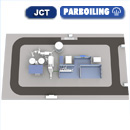The landscape of rice milling is witnessing a seismic shift, thanks to a suite of emerging technologies that are streamlining processes and enhancing productivity. Automation stands at the forefront, where sophisticated machines are equipped with sensors and AI-driven software. These innovations not only minimize human error but also optimize milling parameters on-the-fly, ensuring the highest quality yields. Furthermore, the integration of smart analytics offers mill operators real-time data insights, allowing for timely decision-making and efficient resource management.
Modern rice processing is becoming increasingly focused on incorporating eco-friendly practices that not only boost efficiency but also safeguard the environment. Machinery designed for rice processing now utilizes advanced technologies to minimize water usage and energy consumption during milling. This shift is accompanied by an emphasis on reducing waste, through practices such as:
- Zero Waste Systems: Implementing methods that utilize every by-product of rice milling, such as generating biomass energy from husks.
- Efficient Water Management: Employing water recycling systems that allow water used in the processing stages to be filtered and reused.
- Solar-Powered Solutions: Integrating solar panels with processing plants to harness renewable energy, decreasing reliance on fossil fuels.
Moreover, the advent of smart technologies in rice processing machinery plays a pivotal role in sustainability. With the advent of IoT (Internet of Things), processors can monitor their operations in real-time, leading to optimized performance and reduced energy expenditures. These innovations can be categorized as:
| Innovation Type |
Description |
| Automated Monitoring Systems |
Devices that track equipment performance and alert operators to inefficiencies. |
| Predictive Maintenance |
Using data analytics to predict and address mechanical issues before they arise. |
| Smart Sensors |
Sensors that gauge moisture and temperature to ensure optimal storage conditions. |
The integration of advanced technology into rice processing is reshaping the landscape of quality control. With smart machinery equipped with automation capabilities, producers can streamline their operations while ensuring the highest standards of quality are maintained. These systems are designed to monitor various parameters throughout the processing cycle, making it possible to achieve consistent results and reduce human error. Key features of these innovations include:
Moreover, the effectiveness of these smart systems can be demonstrated through comparative analyses of traditional vs. automated processes. A table showcasing the differences highlights how automation significantly enhances productivity while maintaining quality:
This technological transformation not only aids in producing superior quality rice but also supports sustainability efforts through reduced waste and optimized resource utilization.

